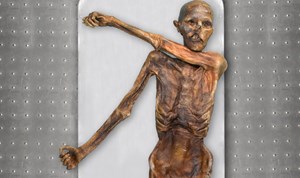
Ötzi's genome was decoded for the first time more than ten years ago. This was also the first time the genome of a mummy had been sequenced. The results provided important insights into the genetic makeup of prehistoric Europeans. Advances in sequencing technology have now enabled a research team from the Max Planck Institute for Evolutionary Anthropology and Eurac Research to reconstruct Ötzi’s genome more accurately.
The results of this recent analysis refine the Iceman’s genetic picture: compared to other contemporary Europeans, Ötzi’s genome has an unusually high proportion of genes in common with those of early farmers from Anatolia. And, contrary to previous findings, at the time of his death, Ötzi had advanced hair loss and may have even been bald. Furthermore, his skin was darker than previously thought. Ötzi’s genes also show a predisposition to diabetes and obesity.
The genetic makeup of most present-day Europeans has resulted mainly from the admixture of three ancestral groups: western hunter-gatherers gradually merged with early farmers who migrated from Anatolia about 8,000 years ago and who were later on joined by Steppe Herders from Eastern Europe, approximately 4,900 years ago.
The initial analysis of the Iceman’s genome revealed genetic traces of these Steppe Herders. However, the refined new results no longer support this finding. The reason for the inaccuracy: the original sample had been contaminated with modern DNA. Since that first study, not only have sequencing technologies advanced enormously, but many more genomes of other prehistoric Europeans have been fully decoded, often from skeletal finds. This has made it possible to compare Ötzi’s genetic code with his contemporaries. The result: among the hundreds of early European people who lived at the same time as Ötzi and whose genomes are now available, Ötzi’s genome has more ancestry in common with early Anatolian farmers than any of his European counterparts.
The research team concludes that the Iceman came from a relatively isolated population that had very little contact with other European groups. “We were very surprised to find no traces of Eastern European Steppe Herders in the most recent analysis of the Iceman genome; the proportion of hunter-gatherer genes in Ötzi’s genome is also very low. Genetically, his ancestors seem to have arrived directly from Anatolia without mixing with hunter gatherer groups,” explains Johannes Krause, head of the Department of Archaeogenetics at the Max Planck Institute for Evolutionary Anthropology in Leipzig, and co-author of the study.
The study also yielded new results about Ötzi's appearance. His skin type, already determined in the first genome analysis to be Mediterranean-European, was even darker than previously thought. “It's the darkest skin tone that has been recorded in contemporary European individuals,” explains anthropologist Albert Zink, study co-author and head of the Eurac Research Institute for Mummy Studies in Bolzano: “It was previously thought that the mummy's skin had darkened during its preservation in the ice, but presumably what we see now is actually largely Ötzi's original skin color. Knowing this, of course, is also important for the proper conservation of the mummy.”
Our previous image of Ötzi is also incorrect regarding his hair: as a mature man, he most likely no longer had long, thick hair on his head, but at most a sparse crown of hair. His genes, in fact, show a predisposition to baldness. “This is a relatively clear result and could also explain why almost no hair was found on the mummy,” says Zink. Genes presenting an increased risk of obesity and type 2 diabetes were also found in Ötzi's genome, however, these factors probably did not come into play thanks to his healthy lifestyle.

ArtDependence Magazine is an international magazine covering all spheres of contemporary art, as well as modern and classical art.
ArtDependence features the latest art news, highlighting interviews with today’s most influential artists, galleries, curators, collectors, fair directors and individuals at the axis of the arts.
The magazine also covers series of articles and reviews on critical art events, new publications and other foremost happenings in the art world.
If you would like to submit events or editorial content to ArtDependence Magazine, please feel free to reach the magazine via the contact page.